A variety with an impeccable taste and aroma - tomato "King of London": reviews, photos and care secrets
Tomato King of London looks more like a tomato tree than an ordinary bush. This giant, two meters tall, has large and delicious fruits shaped like a heart.
Lovers of large-fruited varieties have long paid attention to it, planting it in their beds every year. The hardened Siberian nature of the culture is also considered a huge plus, helping to survive and endow a rich harvest under any circumstances. Description of the variety, agrotechnical techniques and secrets of yield - in the review of the article.
The content of the article
Description of the variety
Despite the name, the variety has nothing to do with England - it appeared thanks to the amateur selection of Siberian scientists. It is not included in the State Register of Breeding Achievements... But this does not prevent him from taking a worthy place among tomato crops and remaining a favorite of hundreds of gardeners.
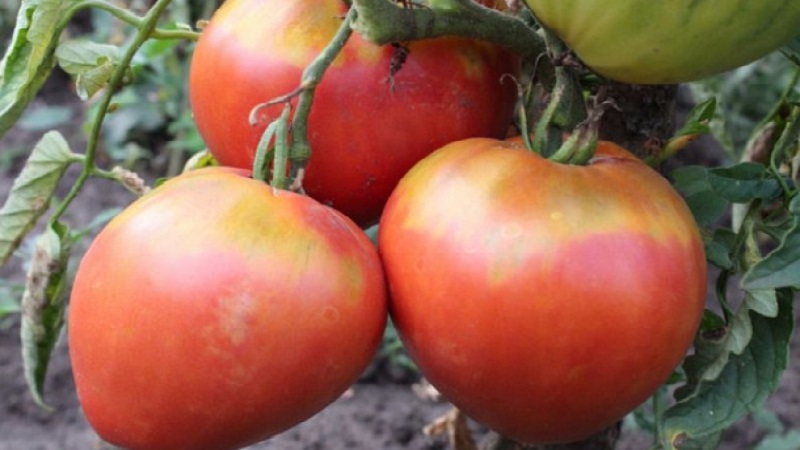
Distinctive features
The type is indeterminate, the height of the bush is 1.5-2 m, the stem is strong, the root system is powerful... Moderate leafiness, medium-sized leaves, light green in color. The inflorescences are simple, the first inflorescence is laid after 9 leaves, the subsequent ones - every 2 leaves. Each brush forms 4-5 fruits.
Mid-early view, from the moment of sowing the seeds to full maturation, 105-110 days pass.
Productivity is high, up to 5 kg are harvested from 1 seedling, provided that no more than 3 plants per 1 sq. m.
Differs in persistent immunity to major diseases the nightshade family such as late blight, tobacco mosaic virus and powdery mildew.
Culture requires obligatory systematic pinching and tying tall bushes.
Recommended for breeding in open field and greenhouse conditions.
Fruit characteristics
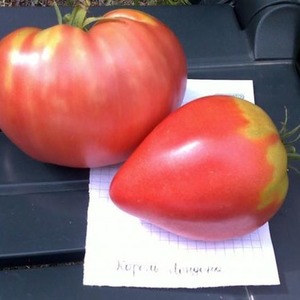 Fruits are large, average weight - 700-800 g, heart-shaped, pink or raspberry color... The taste is excellent, sweet with a characteristic sourness, and has a high content of nutrients. The pulp is juicy, fleshy, the skin is dense. There are 6-8 seed chambers, few seeds.
Fruits are large, average weight - 700-800 g, heart-shaped, pink or raspberry color... The taste is excellent, sweet with a characteristic sourness, and has a high content of nutrients. The pulp is juicy, fleshy, the skin is dense. There are 6-8 seed chambers, few seeds.
The appointment is universal: The fruits are used to prepare various fresh dishes, hot and cold. For winter preparations, canning, pickles and salting vegetables have to be cut because of their large size. They are also great for processing into tomato products: juices, pastes, ketchups.
Ripe vegetables are subject to long storage when creating the necessary conditions: the room must be dry and cool. Thanks to the dense skin, transportation over any distance takes place without losing the presentation.
The photo shows the King of London tomatoes.
It will be interesting:
Ideal for conservation and not capricious "Japanese truffle"
An excellent variety for greenhouses and for open ground - "Nastenka"
A variety for regions with a cold climate - tomato "Red Guard"
How to grow seedlings
Sowing seeds for seedlings begins 2 months before planting in the ground... All indeterminate plant types are grown via seedlings and this tomato is no exception.
Seed preparation
After careful examination for visible defects, the seed is placed in a saline solution for 10 minutes.... In this way, the emptiness of the seeds is determined: those that float to the surface are not suitable for sowing.Then the seeds are disinfected in a weak solution of potassium permanganate for 20 minutes. After disinfection, they are washed with running water and dried.
To improve germination, the seed is germinated on wet gauze for 2-3 days... To do this, the grains are laid out on gauze slightly moistened with warm settled water and left in a dark and warm place at a temperature of at least 28 ° C. After the sprouts appear, the seeds are ready for sowing.
Reference. Germinating seeds on wet gauze significantly improves the germination rate.
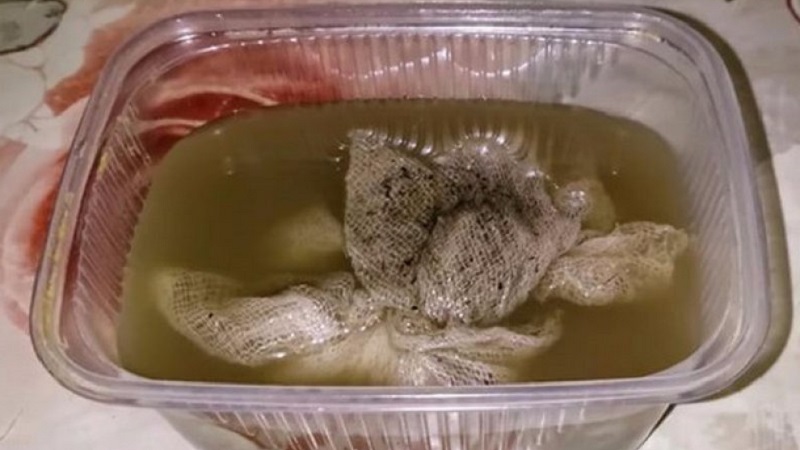
Capacity and soil
The soil is prepared from garden soil, humus, peat and river sand in equal amounts... All components are thoroughly mixed and the resulting mixture is treated with a hot manganese solution to destroy pathogenic flora.
Reference. Soil disinfection is a necessary and indispensable procedure for the healthy growth of seedlings.
The disinfected soil is laid out in planting containers, filling them in half. In the process of seedling growth, the remaining soil is added to the container, thereby providing additional enrichment of the root system with useful substances.
They are planted both in a common box and in separate containers... When sowing in a common container, it must be remembered that in the future, picking of plants will be needed, which can be avoided when planting in individual containers. In addition, it is convenient to transport seedlings to a summer cottage in plastic cups.
Sowing
Seeds are sown to a depth of 1 cm with a distance of 2 cm from each other and sprinkled with earth on top... Slightly compacted and sprinkled with warm, settled water using a spray bottle. The planting containers are covered with foil and left in a warm room at a temperature of 22-24 ° C.
Periodically, the film is removed to ventilate the soil. As the top layer dries up, the soil is moistened with warm, settled water.
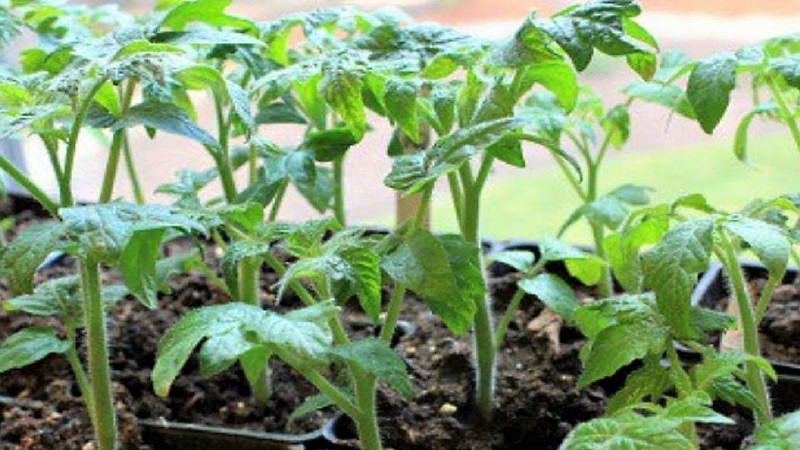
Growing and care
When shoots appear, the containers are rearranged on the windowsill... The duration of daylight hours for seedlings is 14-15 hours, therefore additional lighting is installed in advance. Water the seedlings in moderation, without flooding the sprouts, with warm, settled water using a shallow watering can. After watering, the soil is loosened, thereby providing oxygen to the young roots.
When 2 true leaves appear, the seedlings dive, seating in separate containers. The picking procedure consists in removing the main root by one third, after which there is an enhanced build-up of lateral roots. During a pick, weak plants are utilized, leaving only strong and healthy bushes.
Reference. If the seedlings are left in a common container after picking, it is necessary to increase the distance between seedlings to 15 cm.
During the dive, the bushes are fed liquid fertilizer for tomato seedlings.
2-3 weeks before transplanting, the seedlings are hardened, taking out into the open air for 1 hour in the daytime. Gradually, this interval is increased to 12 hours, while the night temperature in the room is reduced to 13 ° C.
How to grow tomatoes
After two months, the seedlings are ready for transplant.... By this time, the bushes already have 5-7 real leaves and a fully formed root system.
Landing
The soil is prepared in advance, digging with the introduction of complex fertilizers.
Landing scheme: 50 cm - distance between seedlings, 70 cm - distance between rows. For 1 sq. m place 3 plants.
Transplanted on a cloudy day or in the evening into holes 20 cm deep... After transplanting, they are abundantly watered with warm, settled water and left to adapt to new conditions for 8-10 days.
Reference. While getting used to the new conditions, the bushes are not watered or fed.
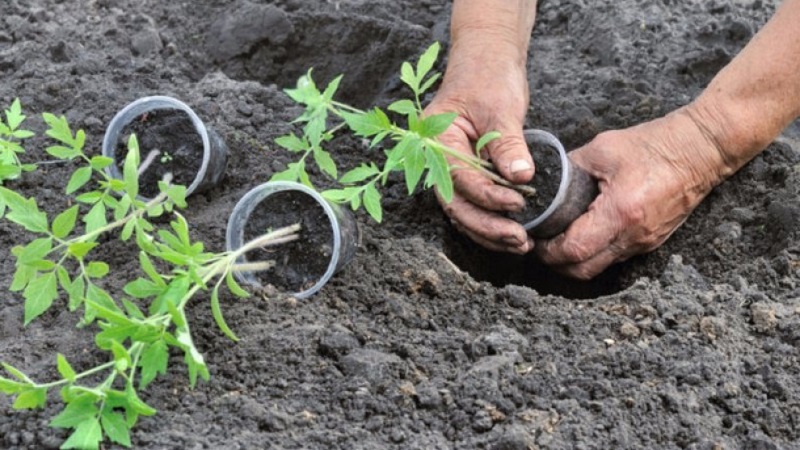
Further care
The main attention in caring for this variety is given to watering.... Watered abundantly, with warm, settled water, strictly under the root, without getting on the leaves. However, it is strongly discouraged to flood the plants: the roots do not like excess moisture and can rot.On dry days, the number of watering is increased, preventing the soil from drying out, and watering is stopped during fruiting.
After watering, the soil is loosened, removing weeds with roots... Weeds take a lot of nutrients from the soil, which are so necessary for the full development of cultivated plants, therefore, the proximity of tomatoes to weeds is not desirable. In addition, weeds are the cause of most fungal infections.
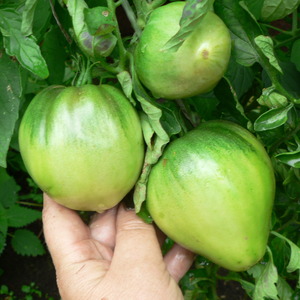 To keep moisture in the beds longer, they are mulched with peat or straw... This is especially necessary on hot days with rapid evaporation of moisture.
To keep moisture in the beds longer, they are mulched with peat or straw... This is especially necessary on hot days with rapid evaporation of moisture.
To obtain excellent large fruits, it is important to observe the feeding regime:
- 2 weeks after transplanting, the plants are fed with nitrogenous fertilizers. After applying nitrogen, the plants increase their green mass intensively, which is necessary for healthy growth.
- During flowering, complete complex mineral fertilizers or organic matter are used. From organic matter, an infusion of mullein or bird droppings is used in a ratio of 1:15.
- At the time of setting the fruits, they are fed with phosphorus-potassium fertilizers for a faster ripening of vegetables.
Read also:
Tomato "Aphrodite f1" loved by gardeners in all regions of the country
Features in care and possible difficulties
Culture needs compulsory pinching, otherwise unnecessary shoots will pick up a lot of nutrients. Plants lead in 1 or 2 stems. Steppes regularly, once every 10 days, thereby not only increasing fruiting to the maximum rate, but also eliminating the thickening of the plantings.
Bushes are tied up immediately after transplanting... To do this, a wooden or metal support is installed next to each plant, to which the stem is fixed. This helps to form a strong and even stem and protects the bushes from gusts of wind. As they grow, fruiting branches are also tied to a support, otherwise they will not support the weight of ripe vegetables.
The ideal option for fixing tall plants is a garter on a trellis... For this, supports are installed from different sides of the beds and a wire is pulled between them. The stem and leaves of the seedlings are fixed to a horizontally stretched wire with soft fabric ribbons.
Diseases and pests
The tomato has established itself as resistant to dangerous diseases, which often infect the nightshade family. But it does not withstand the attacks of insect pests, therefore, preventive measures are aimed specifically at combating insects.
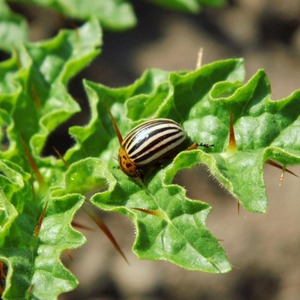 Aphids, whitefly, bear and Colorado potato beetle are dangerous for tomato... Sharp-smelling grasses planted next to the beds save from whiteflies and bears. The bear is also afraid of the smell of garlic, so crushed slices are dug into the beds.
Aphids, whitefly, bear and Colorado potato beetle are dangerous for tomato... Sharp-smelling grasses planted next to the beds save from whiteflies and bears. The bear is also afraid of the smell of garlic, so crushed slices are dug into the beds.
Treatment of the stem with soapy water helps from aphids... If there is a lot of it, the whole plant is sprayed, removing the affected areas.
Colorado beetle - a serious enemy of the tomato crop, capable of destroying a significant part of the plantings. In case of its large accumulation, the drug "Prestige" is used. Bushes are examined for pests on a daily basis.
The nuances of cultivation in the open field and in the greenhouse
In open ground, the culture is planted in the southern regions... In areas with a temperate climate, breeding under a film is recommended, and in the northern regions - only in greenhouse conditions.
In greenhouses, the weight of ripe vegetables exceeds those grown in open beds... Also, the yield rate is higher here - up to 8 kg are harvested from 1 seedling.
Greenhouse plants grow up to 2 m, therefore, you cannot do without pinching the crown. This procedure is needed to indicate the point of growth, since in favorable conditions the indeterminate type grows continuously.
Closed structures are regularly ventilatedso as not to exceed the permissible humidity level. Otherwise, there is a risk of developing fungal spores and plant damage by various infections.In addition, due to a violation of moisture, the fruits crack. If cracks appear, they must be smeared with vegetable oil.

Harvesting and application of the crop
Harvesting ripe vegetables begins in July... Large fruits are of the salad type, therefore they are ideal for fresh consumption. They are used to prepare magnificent summer salads, vegetable stews, hot dishes: soups, stew with vegetables and meat. With regard to preservation, vegetables have to be cut due to their large size. Therefore, they do not try to make winter preparations from them. But they are allowed to process them for tomato products, since tomatoes perfectly retain their acidity in juices, pastes, adjika and ketchup.
Thanks to the dense skin, ripe vegetables are subject to long storage in a cool dry place, until November. This is undoubtedly a big plus, since you can pamper yourself with fresh summer salads all autumn.
Advantages and disadvantages
Culture has many positive qualities:
 adaptation to weather conditions;
adaptation to weather conditions;- high resistance to diseases;
- unpretentious care;
- high rate of fruiting;
- mid-early ripening;
- excellent taste;
- large fruits;
- universal purpose;
- long storage;
- long transportation.
Negative properties include:
- regular pinching;
- obligatory garter;
- cracking of fruits due to high humidity.
Farmers reviews
Judging by the opinions of gardeners, the culture is very popular among gardeners.
Julia, Odessa: “The variety is tall, the bushes have grown by 1.8 m. Despite the fact that I did not completely pinch them, the harvest was large. The fruits weighed 500-600 g, so one tomato is enough to prepare a salad for two people. I was especially surprised by the taste - real, tomato ".
Georgy, Chelyabinsk: “I was visiting a friend and he showed me pictures of his favorite tomatoes. I immediately drew attention to the massive bushes with huge heart tomatoes. I planted it in my greenhouse. Watered and fed infrequently. The vegetables ripened delicious, fleshy and without unpleasant streaks. Very satisfied!".
Conclusion
Tomato King of London is one of the few large-fruited species that can grow in all regions, even the coldest. Due to its unique characteristics - a high rate of fruiting, stable immunity to diseases, simple agricultural technology - the culture has won widespread recognition and continues to conquer new gardeners, replenishing the number of its fans.